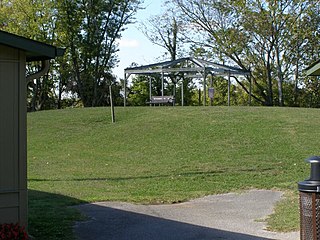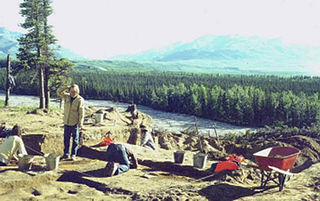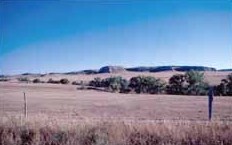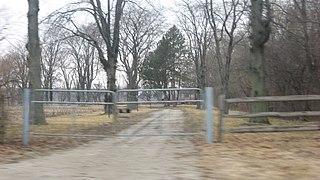
Badin is a town located in Stanly County, North Carolina, United States. At the 2010 census, the town had a total population of 1,974.

Wickliffe Mounds is a prehistoric, Mississippian culture archaeological site located in Ballard County, Kentucky, just outside the town of Wickliffe, about 3 miles (4.8 km) from the confluence of the Ohio and Mississippi rivers. Archaeological investigations have linked the site with others along the Ohio River in Illinois and Kentucky as part of the Angel phase of Mississippian culture. Wickliffe Mounds is controlled by the State Parks Service, which operates a museum at the site for interpretation of the ancient community. Listed on the National Register of Historic Places, it is also a Kentucky Archeological Landmark and State Historic Site.

Lake Jackson Mounds Archaeological State Park (8LE1) is one of the most important archaeological sites in Florida, the capital of chiefdom and ceremonial center of the Fort Walton Culture inhabited from 1050–1500. The complex originally included seven earthwork mounds, a public plaza and numerous individual village residences.

Lubbock Lake Landmark, also known as Lubbock Lake Site, is an important archeological site and natural history preserve in the city of Lubbock, Texas. The preserve is 336 acres and is a protected state and federal landmark. There is evidence of ancient people and extinct animals at Lubbock Lake Landmark. It has evidence of nearly 12,000 years of use by ancient cultures on the Llano Estacado. It is part of the Museum of Texas Tech University.

Town Creek Indian Mound is a prehistoric Native American archaeological site located near present-day Mount Gilead, Montgomery County, North Carolina, in the United States. The site, whose main features are a platform mound with a surrounding village and wooden defensive palisade, was built by the Pee Dee, a South Appalachian Mississippian culture people that developed in the region as early as 980 CE. They thrived in the Pee Dee River region of North and South Carolina during the Pre-Columbian era. The Town Creek site was an important ceremonial site occupied from about 1150—1400 CE. It was abandoned for unknown reasons. It is the only ceremonial mound and village center of the Pee Dee located within North Carolina.

The Double Adobe site is an archaeological site in southern Arizona, twelve miles northwest of Douglas in the Whitewater Draw area. In October 1926, just three months after the first human artifact was uncovered at the Folsom site, Byron Cummings, first Head of the Archaeology Department at the University of Arizona, led four students to Whitewater Draw. Discovered by a schoolboy, the Double Adobe site contained the skull of a mammoth overlying a sand layer containing stone artifacts. One of these students was Emil Haury.

The Modoc Rock Shelter is a rock shelter or overhang located beneath the sandstone bluffs that form the eastern border of the Mississippi River floodplain at which Native American peoples lived for thousands of years. This site is significant for its archaeological evidence of thousands of years of human habitation during the Archaic period in the Eastern United States. It is located on the northeastern side of County Road 7 southeast of Prairie du Rocher in Randolph County, Illinois, United States. It was declared a National Historic Landmark in 1961.

Folsom site or Wild Horse Arroyo, designated by the Smithsonian trinomial 29CX1, is a major archaeological site about 8 miles (13 km) west of Folsom, New Mexico. It is the type site for the Folsom tradition, a Paleo-Indian cultural sequence dating to between 11000 BC and 10000 BC. The Folsom site was excavated in 1926 and found to have been a marsh-side kill site or camp where 32 bison had been killed using distinctive tools, known as Folsom points. This site is significant because it was the first time that artifacts indisputably made by humans were found directly associated with faunal remains from an extinct form of bison from the Late Pleistocene. The information culled from this site was the first of a set of discoveries that would allow archaeologists to revise their estimations for the time of arrival of Native Americans on the North American continent.
Hester Site is a major prehistoric archaeological site in Monroe County, Mississippi. It is a multicomponent site whose major occupation took place during the Archaic period with artifacts dating from 9000 to 8000 BCE, and other occupations during the Woodland and Mississippian periods. The site is one of the largest Archaic sites in the southeastern United States, and its well-stratified nature was critical in providing for accurate relative dating of finds at other sites throughout the region. The site was declared a National Historic Landmark in 2001.

The Dry Creek Archeological Site is an archaeological site not far outside Denali National Park and Preserve. It is a multi-component site, whose stratified remains have yielded evidence of human occupation as far back as 11,000 years ago. The site is located on the northern flanks of the Alaska Range, near Healy, Alaska, in the Nenana River watershed. There are four major components to the site, layered in an outwash terrace overlooking Dry Creek, with layers of loess separating them.

The Iyatayet site is an archaeological site and National Historic Landmark located on the northwest shore of Cape Denbigh on Norton Bay in Nome Census Area, Alaska. It shows evidence of several separate cultures, dating back as far as 6000 B.C. It was excavated starting in 1948 by J. Louis Giddings, the pioneering archaeologist of the area. It is significant as the type site of the Norton culture, representative of human occupation c. 500BCE-500CE, first described by Giddings in 1964. It is also significant for the Denbigh Flint complex, which lay underneath the Norton materials, and provides evidence of some of the earliest human activity in the region. The site was declared a National Historic Landmark in 1961.

Signal Butte is a major prehistoric archaeological site in rural western Nebraska. Designated by the Smithsonian trinomial 25SF1, it was one of the first pre-contact Native American sites to be formally investigated in the central plains. The archaeological sites are located atop the eponymous butte west of Robidoux Pass and Gering, Nebraska. It was declared a National Historic Landmark in 1961. The site is not open to the public.
The Walker Gilmore site, designated by the Smithsonian trinomial 22CC28, is a prehistoric archaeological site near Murray, Nebraska. First formally investigated in 1915, it is the type site for the Sterns Creek focus, the first Woodland period culture identified in Nebraska. It was designated a National Historic Landmark in 1964.
Alcoa Power Generating, Inc. is a subsidiary of Alcoa Inc., headquartered in Pittsburgh, Pennsylvania. Its three divisions were independent subsidiaries before being consolidated into Alcoa Power Generating, Inc. (APGI). These three projects have produced hydroelectric power and manage impoundments which also provide flood control; recreation, residential and business opportunities; and wildlife habitat.

The Dodge Site is an archaeological site in the northwestern part of the U.S. state of Ohio. Located north of Bowling Green in Wood County, the site was inhabited by Middle Woodland and Upper Mississippian peoples. Among the artifacts discovered at the site are ceramics and stone tools. The site's stratigraphy is obvious: the Middle Woodland village site and cemetery can easily be distinguished from the Upper Mississippian occupation zone that sits on top of it. While only a small portion of the 2.2 acre (0.89 ha) site has been excavated, the artifacts that have been discovered at Dodge have contributed significantly to an understanding of the western basin of Lake Erie around AD 1300. Enough material has been recovered to facilitate radiometric dating, as well as identifying the peoples who once inhabited the site. The excavations also revealed the intensity of occupation: the Middle Woodland layer was substantially larger than the exceptionally thin Upper Mississippian component.

Poverty Point State Historic Site/Poverty Point National Monument is a prehistoric earthwork constructed by the Poverty Point culture, located in present-day northeastern Louisiana. Evidence of the Poverty Point culture extends throughout much of the Southeastern Woodlands of the Southern United States. The culture extended 100 miles (160 km) across the Mississippi Delta and south to the Gulf Coast.

Shawnee-Minisink Site is a prehistoric archaeological site located in Smithfield Township, Monroe County, Pennsylvania in the upper Delaware Valley. It was the site of a Paleoindian camp site. It was added to the National Register of Historic Places in 2007.

The Hidden Valley Rockshelter (44-BA-31) is a significant archaeological site located near the community of Warm Springs in Bath County, Virginia, United States. A large rockshelter located near the Jackson River, it has been occupied by humans for thousands of years, and it has been named a historic site.
The Swan Point Archeological Site is located in eastern central Alaska, in the Tanana River watershed. It is one of a collection of sites in the area that have yielded the oldest evidence of human habitation in the state, in addition to megafauna no longer found in Alaska, such as wapiti (elk), bison, and woolly mammoth. Finds co-located with human artifacts at the site have given radiocarbon dates of 14,000 years, indicating the site was occupied around 12,000 BCE. Swan Point is the oldest archaeological site in the Americas whose age is certain.
The Doerschuk Site is a prehistoric archaeological site with remains from the Archaic period in North America located near Badin, Montgomery County, North Carolina. The Doerschuk Site was first recorded in 1948 by H. M. Doerschuk. The site is privately owned by the Aluminum Company of America (ALCOA).




















